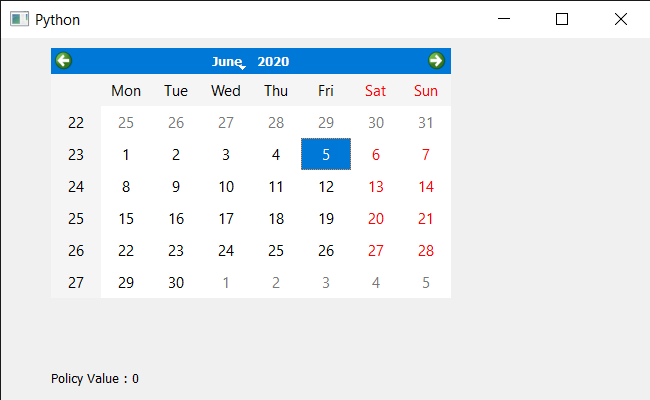PyQt5 QCalendarWidget – 获取它的上下文菜单策略
在这篇文章中,我们将看到如何获得QCalendarWidget的上下文菜单策略。上下文菜单策略告诉我们日历将如何显示上下文菜单,有很多策略可用于日历,如NoContextMenu,PreventContextMenu等。默认情况下,日历有DefaultContextMenu作为上下文策略,尽管我们可以在setContextMenuPolicy方法的帮助下改变它。
为了做到这一点,我们将使用QCalendarWidget对象的contextMenuPolicy方法。
语法: calendar.contextMenuPolicy()
参数: 它不需要参数
返回: 它返回内容菜单策略对象,但是当打印时,它会显示策略的相关值。
下面是实现
# importing libraries
from PyQt5.QtWidgets import *
from PyQt5 import QtCore, QtGui
from PyQt5.QtGui import *
from PyQt5.QtCore import *
import sys
class Window(QMainWindow):
def __init__(self):
super().__init__()
# setting title
self.setWindowTitle("Python ")
# setting geometry
self.setGeometry(100, 100, 650, 400)
# calling method
self.UiComponents()
# showing all the widgets
self.show()
# method for components
def UiComponents(self):
# creating a QCalendarWidget object
self.calendar = QCalendarWidget(self)
# setting geometry to the calendar
self.calendar.setGeometry(50, 10, 400, 250)
# setting context menu policy
self.calendar.setContextMenuPolicy(Qt.NoContextMenu)
# creating a label
label = QLabel(self)
# setting geometry
label.setGeometry(50, 280, 420, 120)
# making it multi line
label.setWordWrap(True)
# getting context menu policy
value = self.calendar.contextMenuPolicy()
# setting text to the label
label.setText("Policy Value : " + str(value))
# create pyqt5 app
App = QApplication(sys.argv)
# create the instance of our Window
window = Window()
# start the app
sys.exit(App.exec())
输出:

 极客教程
极客教程